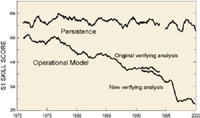


Australian Meteorology through the 20th Century
Introduction
The Origins of Australian Meteorology
Meteorology in the 20th Century
The Weather and Climate of the Twentieth Century
The Great Weather and Climate Events of the Twentieth Century
A Century of Progress in Science and Service
Observing the Structure and Behaviour of the Atmosphere
Radar and Satellite Meteorology
Numerical Weather Prediction
Modelling of Climate
Service to the Community
References
Australian Meteorological Milestones of the 20th Century
Endnotes
Index
Search
Help
Contact us

Numerical Weather Prediction
Following the establishment of the World Weather Watch in 1964, and the Australian commitment to operating one of the three World Meteorological Centres, Australian meteorologists moved quickly to develop a world class research effort in the then emerging field of numerical weather prediction.Research carried out in the Australian Numerical Meteorology Research Centre (ANMRC), and subsequently the Bureau of Meteorology Research Centre (BMRC) in close collaboration with overseas research centres, has enabled the Bureau, with the aid of powerful computers first installed in 1968 and progressively upgraded in line with the international state of the art, to operate global, regional and local numerical weather prediction models providing skilful guidance to weather forecasters throughout Australia and its neighbouring countries.
The steady increase in skill since the first introduction of numerical prediction models into the operations of the Bureau in the early 1970s is shown in Figure 18.

Modelling of Climate
Essentially the same models used for numerical weather prediction have, over the past twenty-five years, been progressively converted into climate simulation models by building in the longer term influence and behaviour of the oceans. Both the Bureau and CSIRO now operate sophisticated atmosphere-ocean general circulation models capable of simulating the behaviour of the global climate system—for use both in predicting the natural (El Niņo and related) fluctuations of Australian climate on time-scales of months to years and projecting future patterns of greenhouse-induced climate change over Australia under various greenhouse gas emission scenarios. Although these models have demonstrated significant skill for seasonal to interannual prediction, there is, so far, little confidence in their ability to provide reliable guidance on greenhouse time-scales beyond indicating a general warming trend over the continent during the twenty-first century, with more warming in the interior than near the coast.Service to the Community
Meteorology is one of the most scientifically challenging but also most practically useful fields of science there is. The observing, data collection and modelling work of the Bureau provides the basis for a wide range of services to the Australian community at large and to most major economic sectors including agriculture, transport, energy and the information industries.Although limited in scope and accuracy in the early part of the century, the Bureau's forecasts have steadily increased in lead time, skill and utility and now provide the basis for many millions of important weather and climate sensitive decisions every day. Economic valuation studies suggest that the overall benefit to the Australian community from the services of the Bureau at the close of the twentieth century exceed their cost by at least an order of magnitude. The continuing progress in national and international meteorological science and technology suggests the opportunity for even greater benefits in terms of safety of life, environmental protection and enhanced social and economic wellbeing through the twenty-first century (Zillman 1999).
Organisations in Australian Science at Work - Australian Numerical Meteorology Research Centre; Bureau of Meteorology Research Centre
 |
Bureau of Meteorology |  |
© Online Edition Australian Science and Technology Heritage Centre and Bureau of Meteorology 2001
Published by Australian Science and Technology Heritage Centre, using the Web Academic Resource Publisher
http://www.austehc.unimelb.edu.au/fam/1614.html